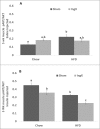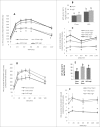Lower body adipose tissue removal decreases glucose tolerance and insulin sensitivity in mice with exposure to high fat diet
- PMID: 26167400
- PMCID: PMC4496982
- DOI: 10.4161/21623945.2014.957988
Lower body adipose tissue removal decreases glucose tolerance and insulin sensitivity in mice with exposure to high fat diet
Abstract
It has been postulated that the protective effects of lower body subcutaneous adipose tissue (LBSAT) occur via its ability to sequester surplus lipid and thus serve as a "metabolic sink." However, the mechanisms that mediate this protective function are unknown thus this study addresses this postulate. Ad libitum, chow-fed mice underwent Sham-surgery or LBSAT removal (IngX, inguinal depot removal) and were subsequently provided chow (Chow; typical adipocyte expansion) or high fat diet (HFD; enhanced adipocyte expansion) for 5 weeks. Primary outcome measures included glucose tolerance and subsequent insulin response, muscle insulin sensitivity, liver and muscle triglycerides, adipose tissue gene expression, and circulating lipids and adipokines. In a follow up study the consequences of extended experiment length post-surgery (13 wks) or pre-existing glucose intolerance were examined. At 5 wks post-surgery IngX in HFD-fed mice reduced glucose tolerance and muscle insulin sensitivity and increased circulating insulin compared with HFD Sham. In Chow-fed mice, muscle insulin sensitivity was the only measurement reduced following IngX. At 13 wks circulating insulin concentration of HFD IngX mice continued to be higher than HFD Sham. Surgery did not induce changes in mice with pre-existing glucose intolerance. IngX also increased muscle, but not liver, triglyceride concentration in Chow- and HFD-fed mice 5 wks post-surgery, but chow group only at 13 wks. These data suggest that the presence of LBSAT protects against triglyceride accumulation in the muscle and HFD-induced glucose intolerance and muscle insulin resistance. These data suggest that lower body subcutaneous adipose tissue can function as a "metabolic sink."
Keywords: adipose tissue distribution; lipectomy; metabolic sink; muscle; subcutaneous adipose issue; triglyceride; visceral adipose tissue.
Figures








Similar articles
-
Subcutaneous adipose tissue accumulation protects systemic glucose tolerance and muscle metabolism.Adipocyte. 2018;7(4):261-272. doi: 10.1080/21623945.2018.1525252. Epub 2018 Sep 30. Adipocyte. 2018. PMID: 30230416 Free PMC article.
-
Subcutaneous Adipose Tissue Transplantation in Diet-Induced Obese Mice Attenuates Metabolic Dysregulation While Removal Exacerbates It.Physiol Rep. 2013 Aug;1(2):e00015. doi: 10.1002/phy2.15. Physiol Rep. 2013. PMID: 23914298 Free PMC article.
-
Opposing effects of reduced kidney mass on liver and skeletal muscle insulin sensitivity in obese mice.Diabetes. 2015 Apr;64(4):1131-41. doi: 10.2337/db14-0779. Epub 2014 Oct 16. Diabetes. 2015. PMID: 25325737
-
Expansion of the Inguinal Adipose Tissue Depot Correlates With Systemic Insulin Resistance in C57BL/6J Mice.Front Cell Dev Biol. 2022 Sep 7;10:942374. doi: 10.3389/fcell.2022.942374. eCollection 2022. Front Cell Dev Biol. 2022. PMID: 36158197 Free PMC article.
-
Adipose triglyceride lipase-null mice are resistant to high-fat diet-induced insulin resistance despite reduced energy expenditure and ectopic lipid accumulation.Endocrinology. 2011 Jan;152(1):48-58. doi: 10.1210/en.2010-0661. Epub 2010 Nov 24. Endocrinology. 2011. PMID: 21106876
Cited by
-
A Systematic Scoping Review of Surgically Manipulated Adipose Tissue and the Regulation of Energetics and Body Fat in Animals.Obesity (Silver Spring). 2019 Sep;27(9):1404-1417. doi: 10.1002/oby.22511. Epub 2019 Jul 30. Obesity (Silver Spring). 2019. PMID: 31361090 Free PMC article.
-
Sex Differences in Adipose Tissue Distribution Determine Susceptibility to Neuroinflammation in Mice With Dietary Obesity.Diabetes. 2023 Feb 1;72(2):245-260. doi: 10.2337/db22-0192. Diabetes. 2023. PMID: 36367881 Free PMC article.
-
Subcutaneous adipose tissue accumulation protects systemic glucose tolerance and muscle metabolism.Adipocyte. 2018;7(4):261-272. doi: 10.1080/21623945.2018.1525252. Epub 2018 Sep 30. Adipocyte. 2018. PMID: 30230416 Free PMC article.
-
Lipectomy associated to obesity produces greater fat accumulation in the visceral white adipose tissue of female compared to male rats.Lipids Health Dis. 2019 Feb 9;18(1):44. doi: 10.1186/s12944-019-0988-5. Lipids Health Dis. 2019. PMID: 30738429 Free PMC article.
-
TMT Labeling Reveals the Effects of Exercises on the Proteomic Characteristics of the Subcutaneous Adipose Tissue of Growing High-Fat-Diet-Fed Rats.ACS Omega. 2023 Jun 21;8(26):23484-23500. doi: 10.1021/acsomega.3c00627. eCollection 2023 Jul 4. ACS Omega. 2023. PMID: 37426235 Free PMC article.
References
-
- Haffner SM. Relationship of metabolic risk factors and development of cardiovascular disease and diabetes. Obesity (Silver Spring) 2006; 14 Suppl 3:121S-7S; PMID:16931493; http://dx.doi.org/10.1038/oby.2006.291 - DOI - PubMed
-
- Prospective Studies C, Whitlock G, Lewington S, Sherliker P, Clarke R, Emberson J, Halsey J, Qizilbash N, Collins R, Peto R. Body-mass index and cause-specific mortality in 900 000 adults: collaborative analyses of 57 prospective studies. Lancet 2009; 373:1083-96; PMID:19299006; http://dx.doi.org/10.1016/S0140-6736(09)60318-4 - DOI - PMC - PubMed
-
- Sims EA. Are there persons who are obese, but metabolically healthy? Metabolism 2001; 50:1499-504; PMID:11735101; http://dx.doi.org/10.1053/meta.2001.27213 - DOI - PubMed
-
- Reaven GM. Importance of identifying the overweight patient who will benefit the most by losing weight. Ann Intern Med 2003; 138:420-3; PMID:12614095; http://dx.doi.org/10.7326/0003-4819-138-5-200303040-00012 - DOI - PubMed
-
- Ferrannini E, Natali A, Bell P, Cavallo-Perin P, Lalic N, Mingrone G. Insulin resistance and hypersecretion in obesity. European Group for the Study of Insulin Resistance (EGIR). J Clin Invest 1997; 100:1166-73; PMID:9303923; http://dx.doi.org/10.1172/JCI119628 - DOI - PMC - PubMed
Grants and funding
LinkOut - more resources
Full Text Sources
Other Literature Sources
